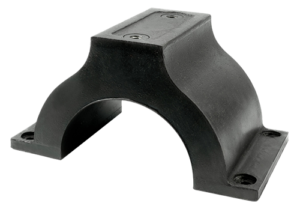Case Study
Problem:
A customer came to Hutchinson seeking a shock protection solution for their client’s shipboard “friend or foe” detection electronics box. The client wanted to use a Cablemount solution, but modeling showed that its output was too close to limits with little to no safety factor.
Solution:
Through extensive modeling and analyses, we demonstrated that our VHC (Very High Capacity) elastomeric solution was a much safer and more robust choice for shock protection than the Cablemount.
Results:
Reality matched our analyses and theories, as the Cablemount system failed quickly during an in-person shock test. We then tested the VHC system, which passed with flying colors—allowing our customer to keep their program on schedule and on budget. The part is now in production.
Shipping Out an Elastomeric Shock Protection Solution
Ensuring that military technology continues to function properly under stressful and dangerous situations can be the difference between a mission’s success and failure. So, when a customer asked Hutchinson to help develop a shock protection solution for a shipboard “friend or foe” detection electronics box for the United States Navy, we were ready to assist.
Our extremely knowledgeable and experienced engineering, analyst and materials teams ultimately designed an elastomeric solution that proved to be much safer and more robust than the shock protection system the U.S. Navy initially wanted to use, allowing our customer to keep their program on schedule and on budget.
Uncovering the Problem
The shipboard “friend or foe” detection device was to be used on U.S. Navy vessels, and our customer needed a shock protection solution that could perform optimally under very specific circumstances, so they reached out to Hutchinson for help. From the outset, the Navy was dead-set on using a Cablemount system, which is made up of coiled cables laid on their sides, to protect the 2’x2’x2’ electronics box from shock.
Using our proprietary BarrySoft Advanced 6 Degree of Freedom, rigid body shock, vibration and static force analysis software, we ran models of the Cablemount solution under different levels of shock and found that it was too close to shock limits with little to no safety factor—in other words, it did not leave any room for possible error. Since modeling showed that the Cablemount solution was almost sure to fail in real-life shock testing, our experienced team decided to test other solutions as potential alternatives.
Finding a Solution
Again using BarrySoft Advanced, our team determined that our existing VHC (Very High Capacity) elastomeric solution was a much safer alternative for providing shock protection than the Cablemou

nt system. We also used finite element analysis (FEA) to demonstrate the structural integrity of both the Cablemount and elastomeric solutions to the customer.
Once we explained the properties of both solutions, our customer procured our alternate VHC system for testing, along with the Cablemount system that the Navy wanted.
Getting Results
Our team attended Deck Simulating Shock Machine (DSSM) testing at National Technical Systems (NTS) in Virginia to provide on-site support and expertise to those running the shock tests.
It didn’t take long for our concerns about the Cablemount system’s durability under shock to become real during testing; it quickly broke and failed the test. Since we had the VHC elastomeric solution on deck, we were able to test it right away. As we expected, the VHC elastomer mounts provided positive results during shock testing and were ultimately chosen over the Cablemount system by our customer.
Since the project did not require us to create a brand-new elastomer from scratch, our customer saved time and money that would have otherwise been spent on research and development. In fact, we were able to essentially pull our existing VHC-series mount off the shelf for turnkey use in this application, keeping the customer’s program on schedule and on budget.
Our customer was also able to provide the Navy with a workable solution to reduce shipboard shock levels in their electronics that was backed up with analyses and test data. The custom base system using the VHC elastomer part is now in production.
At Hutchinson, we leverage our combined years of industry knowledge and experience to provide high-quality and customizable shock and vibration solutions that will exceed customer expectations.
If you are interested in learning more about our capabilities, or if you want to speak with us about your project, we’d love to connect. Reach out today to learn more.
Quick Contact Form
The personal data collected are processed, the responsibility of which is HUTCHINSON AEROSPACE & INDUSTRY INC. company, in order to respond to your request for information and/or for the purpose of commercial prospecting. Mandatory fields to be completed are marked with an asterisk. The legal basis for the processing is your consent, which you may withdraw at any time, without prejudice to previous processing operations. Personal data are reserved for the use of the HUTCHINSON group and may only be transmitted to companies of the HUTCHINSON group and/or commercial partners for commercial purposes, if you have expressly consented to this.
In accordance with the regulation relating to personal data (GDPR), you have the right of access, rectification and erasure of your personal data, as well as the right of opposition to their processing. You may request the disclosure of your personal data and you have the right to define guidelines for the treatment of your personal data after your death. You can also request the portability of your data as well as the limitation of their processing, and/or file a complaint to your local authority.
You can exercise your rights and ask us about the processing of your personal data by contacting us at the following email address: [email protected]
To find out more read our Privacy and Cookies Policy.
